In-Depth Insights into the Tourmaline Surf Report
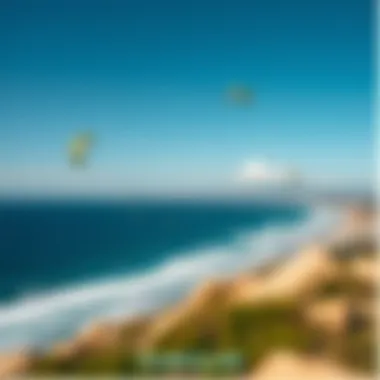

Intro
Kiteboarding at Tourmaline Beach can be a mixed bag. With its dynamic conditions and ever-changing tides, it’s a hotspot for both thrill-seekers and serene riders alike. Understanding the intricacies of the Tourmaline surf report is paramount for anyone aiming to catch waves and make the most of their time on the water.
This comprehensive analysis digs into every aspect of the surf report, helping kiteboarders navigate the waves with both skill and insight. From the specifics of the location to the nuances of wave conditions, we will cover the critical details that affect your kiteboarding experience.
Aside from evaluating the surf conditions, we’ll also chat about the essential gear needed for kiteboarding at this famed beach. Furthermore, you'll find helpful tips that can elevate a novice rider from wobbling at the water's edge to carving through the surf like a seasoned pro. Let’s dive in!
Preface to the Tourmaline Surf Report
Understanding the intricacies of the Tourmaline surf report is crucial for anyone looking to enjoy kiteboarding in these famed waters. The surf report acts as a window into not just the conditions of the ocean but also the atmosphere surrounding the surf scene. This document focuses on relevant factors: wave quality, tidal influences, and seasonal changes that determine the best times to ride the waves. It's an essential tool for both seasoned veterans and newcomers eager to navigate the waters safely and effectively.
Significance of Surf Reports
Surf reports play a pivotal role in helping surfers harness the power of nature. Having access to accurate and timely information allows kiteboarders to make informed decisions that can greatly enhance their experiences on the water. Here are several reasons why surf reports hold such significance:
- Preparation: By knowing wave heights and wind patterns, surfers can tailor their gear to meet specific conditions, ensuring they are well-equipped for the challenges ahead.
- Safety: Surf reports often include warnings about hazardous conditions, which is especially vital for those who are still learning the ropes. An informed surfer stands a better chance of avoiding dangerous situations.
- Timing: The right conditions can make or break a session. Surf reports provide insights into the optimal times for riding, helping enthusiasts find the sweet spots when the waves are just right.
The surf report is a blend of art and science—observations combining meteorological data, local knowledge, and even historical patterns. It's the kind of information that can change a mundane day into an exhilarating adventure.
Overview of Tourmaline
Nestled along the gorgeous coastline of Southern California, Tourmaline Beach has earned a reputation as a prime destination for kiteboarders. The area is distinguished by its unique landforms and currents, which contribute to varying surf conditions throughout the year.
Tourmaline Beach is particularly notable for its accessibility. Located just a stone's throw away from major urban centers, surfers have the luxury of a beautiful beach combined with a vibrant community. The unique alignment of the coastline creates an amphitheater effect that can enhance wave performance, drawing in both experienced and amateur kiteboarders alike.
Among the local landmarks, the Tourmaline Surfing Park stands out, where both seasoned surfers and newcomers alike gather to share tips, stories, and experiences. This hub of activity fosters a sense of camaraderie and connection unique to the Tourmaline surf culture.
In summary, the Tourmaline surf report serves as an essential resource for navigating the waters at this iconic beach. It brings awareness to various elements, from the local geography to the broader environmental influences, making it an indispensable tool for surfers aiming to maximize their time on the water.
Geographical Context of Tourmaline Beach
Understanding the geographical context of Tourmaline Beach serves as a cornerstone for anyone hoping to navigate the intricacies of its surf report. This section sheds light on the location's defining characteristics and surrounding landmarks, which can significantly impact surfing conditions. The dynamics of waves, tides, and winds are all influenced by the geographical attributes of this beach, making it critical for kiteboarders and surf enthusiasts alike to grasp these elements thoroughly.
Location Characteristics
Tourmaline Beach is nestled in the heart of the bustling Pacific coastline of San Diego, California. Its geographical coordinates place it as an easily accessible spot for both locals and visitors alike. The beach stretches along a gentle curve, bordered by rugged cliffs and sandy dunes. Notably, its orientation towards the prevailing northwesterly swells allows it to catch consistent and rideable waves, making it a coveted spot for water sports.
The surrounding areas are mostly residential, with vibrant beach communities that bring a lively ambiance to the spot. This proximity brings certain benefits:
- Accessibility: Tourmaline Beach is straightforward to reach from major highways
- Amenities: Nearby cafes and rental shops cater to kiteboarders and surfers, providing necessary gear and refreshments
- Sheltered Environment: The surrounding cliffs create a buffer from harsh wind, offering milder conditions for beginners who are still finding their sea legs
However, it’s also worth noting potential drawbacks. For instance, during peak tourist season, the beach can become crowded, which may affect one’s surfing experience. Understanding this geographical context allows surfers to plan their visits strategically, seeking the best times to hit the waves.
Surrounding Landmarks
Familiarity with the landmarks around Tourmaline Beach enriches one's overall experience and provides useful reference points. To the south lies La Jolla, renowned for its picturesque views and marine life. Due north, you will find the beautiful Pacific Beach, known for its lively social scene. Key landmarks include:
- Palтайn Point: A prominent cliff offering breathtaking views, perfect for scouting surf conditions and checking wave heights before hitting the water.
- Torrey Pines Natural Reserve: A short drive away, this coastline offers unique trails and stunning vistas. It makes for a great spot to unwind after a long day in the water.
- The Marine Room: With its beachfront dining experience, this restaurant provides surfers with a splendid view of forthcoming waves while enjoying a meal.
These landmarks not only enhance the overall surfing context but also foster a stronger connection with the local culture, making it more than just a surfing destination.
"The geographical essence of a surf spot can truly shape the waves it produces, infusing every session with the spirit of the land and sea."
In summary, knowing the geographical context of Tourmaline Beach is pivotal when interpreting its surf report. From location characteristics to surrounding landmarks, each element plays a role in understanding what it means to ride the waves here. By having this knowledge, one can optimize their surfing conditions, enjoying a richer and more fulfilling experience.
Understanding Surf Conditions
Surf conditions are a crucial element in the experience of kiteboarding at Tourmaline Beach. The interplay of different factors like wave height, the types of breaks, and wind conditions can define not just the thrill of riding waves but also the overall safety and enjoyment. Having a firm grasp of these aspects allows kiteboarders—whether just picking up a board for the first time or seasoned veterans—to make informed decisions when they hit the water.
An understanding of surf conditions also has broader implications that extend beyond the immediate enjoyment of the sport. With accurate predictions and awareness of conditions, surfers can plan their outings effectively, ensuring they are in the right place at the right time. This not only helps in maximizing the fun but also in minimizing risks associated with poor weather or hazardous wave heights.
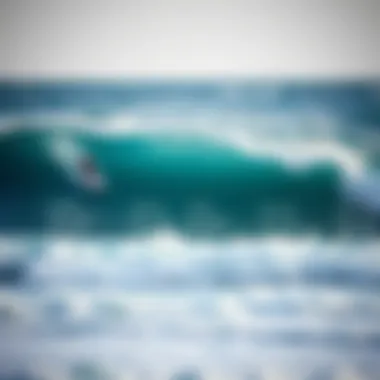
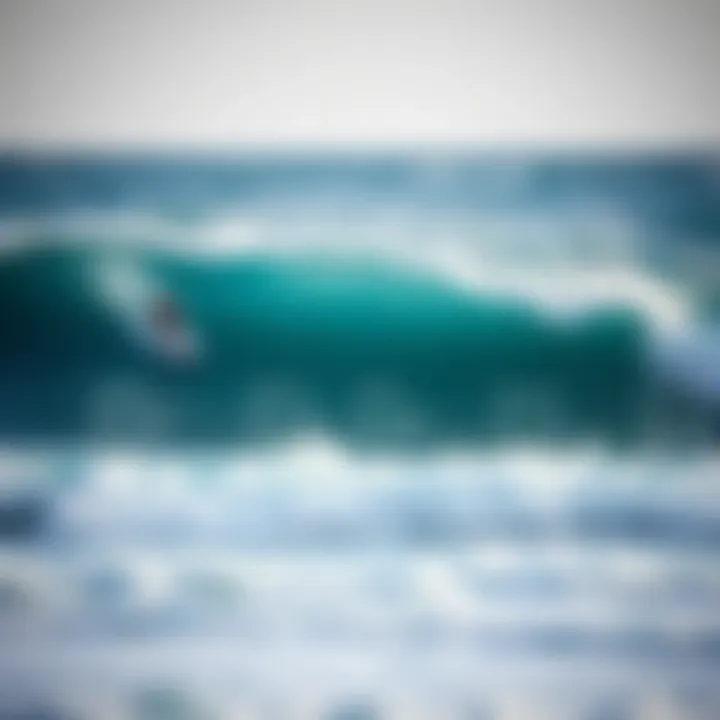
Additionally, learning about surf conditions fosters a connection with the ocean and its behaviour. When you recognize how various conditions shape the waves, it builds a deeper respect and appreciation for the natural environment.
Wave Height and Break Types
The height of the waves can significantly influence not just the thrill factor but also the level of difficulty you might face while kiteboarding. Waves are categorized in various ways—some are gentle, rolling swells, while others can be steep, powerful breakthroughs. Here’s a closer look at how wave height and break types interact:
- Small Waves (1-3 feet): Ideal for beginners, small waves offer a forgiving environment where riders can hone their skills. They provide a chance to focus on balance and control without the fright of getting overwhelmed by larger surf.
- Medium Waves (3-6 feet): These heights are where intermediate riders often find their sweet spot. It's all about learning to read the wave and how to navigate it effectively. This range can also feature varied breaks—some breaking to the left, others to the right, which is crucial in planning your maneuvers.
- Large Waves (6 feet and above): Only seasoned kiteboarders should tackle these conditions. Large waves often come with considerable challenge, requiring expert skills and an understanding of safety precautions. The energy and force of these waves can be intense, altering the dynamics of even the most experienced riders.
Moreover, the types of breaks—like point breaks, beach breaks, and reef breaks—add another layer of complexity. Each type brings its own characteristics:
- Point Breaks: These are generally consistent and often produce long rides. Ideal for experienced surfers who know how to catch the wave at just the right moment.
- Beach Breaks: More common at Tourmaline, these can vary daily based on sand shifts, making each session a unique challenge.
- Reef Breaks: While not as prevalent at Tourmaline, they offer a reliable wave shape and pattern but require a keen awareness of landing zones to avoid sharp coral.
Wind Conditions
Wind is the unsung hero of kiteboarding. The right wind can transform an average day into an epic session, whereas poor wind conditions can lead to disappointing outings. Understanding how different wind strengths affect the surf conditions is paramount:
- Light Winds (less than 10 knots): In these conditions, surfers may struggle. Light breezes might leave the water flat and uninviting. However, this could be an opportunity for beginners to practice on the water without the complications of high winds.
- Moderate Winds (10-20 knots): Goldilocks territory. This range typically provides enough lift for kiteboarding to be truly enjoyable. The ability to maneuver and catch waves effectively increases significantly in these wind conditions.
- Strong Winds (20+ knots): For those who thrive on adrenaline, strong winds can offer thrilling experiences. While exhilarating, such conditions require experience. Strong winds can lead to powerful gusts that can throw off even the most experienced riders, making it vital to recalibrate techniques and equipment.
Finally, pay attention to wind direction—not only its strength. Offshore winds can create smoother waves with bigger swells, while onshore winds can lead to choppy waters, affecting stability and ride quality.
By honing in on wave height and wind conditions, kiteboarders at Tourmaline can elevate their surfing game and ensure a safer, more enjoyable experience.
Tidal Influences on Surfing
Understanding tidal influences can be likened to reading the mood of the ocean. These fluctuations dictate not just how high or low the water is but also shape the very essence of the surfing experience at Tourmaline Beach. This section will unwrap the complexities of how the tides can alter wave dynamics and impact surf conditions.
Tides are caused primarily by the gravitational pull of the moon and, to a lesser extent, the sun. The resulting rise and fall of the sea level can significantly affect wave formation and surfability. For kiteboarders, this means paying close attention to tidal patterns—a key factor that can mean the difference between a good day on the water and one that's less than ideal.
High Tide vs Low Tide Profiles
During high tide, the water level reaches its peak, offering a different profile for waves compared to low tide. Here, I'll break down the nuances of both:
- High Tide:
At high tide, waves often convert into powerful, steep breaks that can provide thrilling rides. This is due to the waves gaining speed as they approach shallow waters hugging the shore. However, the presence of strong currents can sometimes make it challenging to catch these waves. - Low Tide:
Conversely, low tide exposes sandbars and rocks, forming more consistent breaks that can be ideal for various skill levels. Those who are not as experienced will benefit from the slower waves often found at this stage. However, caution is key; navigating shallow waters might present hazards.
The critical takeaway here is that understanding the profiles at both high and low tides equips surfers with the capacity to adjust their approaches, maximize enjoyment, and maintain safety.
Optimal Tidal Timing for Waves
Not all tides are created equal when it comes to surfing conditions. Timing becomes crucial, so it's important to know when to hit the waves. Ideally, kiteboarders should aim to surf approximately one hour before and after high tide. This window presents the perfect opportunity, as the swell is typically at its most dynamic and powerful, enhancing performance.
Conversely, just before low tide often yields well-defined breaks ideal for riding but can come with the trade-off of a less robust wave quality. A deeper understanding of the tidal cycle—through tools like tidal charts and local surf reports—can sharpen a kiteboarder's edge.
"Surfing and tidal awareness go hand in hand. Recognizing the rhythms of the tides can elevate the overall kiteboarding experience."
In summation, the tidal influences at Tourmaline Beach are not merely background features; they play a crucial role in shaping surf conditions. Taking the time to study these patterns and anticipate shifts can lead to more enjoyable and safe kiteboarding adventures. The ocean is a complex partner; knowledge is key to mastering it.
Seasonal Variations in Surfing Conditions
Understanding seasonal variations in surfing conditions is crucial for kiteboarders looking to maximize their time on the water. Each season brings its own set of unique conditions that can significantly impact wave quality, wind patterns, and overall experience on Tourmaline Beach. This section highlights these variations, providing insights essential for both novice and advanced surfers alike.
Summer Conditions
During summer, Tourmaline Beach typically experiences more stable weather and generally smaller swells. The weather is usually warm, making it a prime time for leisure kiteboarding. In this season, light winds prevail, often providing fair conditions for beginners to hone their skills without the intimidation of aggressive waves. Kiteboarders can expect gentle waves, which are great for practicing tricks or simply enjoying the ride.
In terms of equipment, lighter boards and kites are often favored during the summer. Kite setup adjustments can help take advantage of the lower wind speeds. When planning summer outings, one should also consider the tidal influences, as the low tides can lead to flatter water, benefitting those still developing their balance in the water.
To illustrate, many local kiteboarding schools offer summer camps for those looking to learn. These camps create an environment where students can not only enhance their technical skills but also develop a deeper connection with fellow surfers in a community-focused atmosphere.
Winter Swells
Winter at Tourmaline Beach presents a different picture for surfers—markedly larger swells and stronger winds define this season. The wave heights can often become quite substantial, creating perfect conditions for seasoned kiteboarders seeking a challenge. The thrill of tackling these robust waves attracts many experienced kiteboarders, eager to ride the more dynamic surf.
Safety becomes paramount during winter, as the shifting weather can lead to unpredictable conditions. Those venturing into the waters need to be familiar with local hazards and comfortable with their gear. A robust understanding of personal limits is necessary, especially when faced with the heightened complexity of winter waves. Advanced kiteboarding bags and sturdy boards become essential tools for those navigating these lively swells.
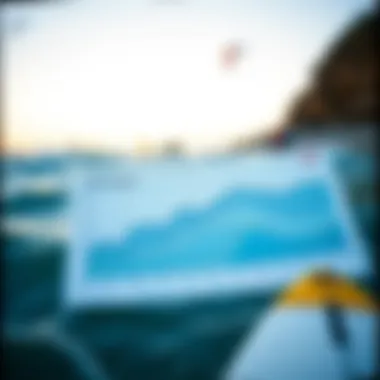
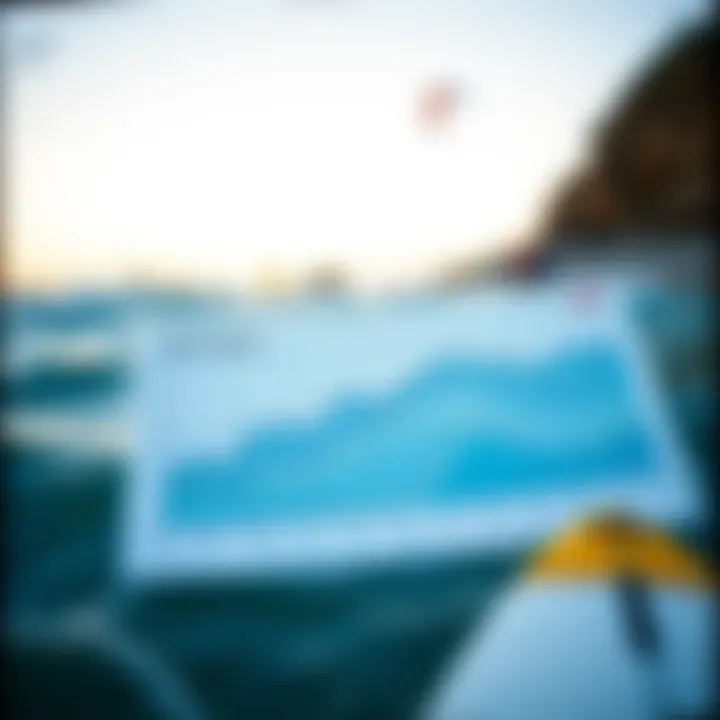
As winter rolls in, kiteboarders often gather for community events, including contests that showcase freestyle talents against the stunning backdrop of crashing waves.
Taking part in these events not only tests individual skills but also strengthens the ties within the local kiteboarding community. Resources like the Kiteboarder Magazine and local forums on reddit.com provide excellent insights and tips for navigating both summer and winter conditions.
By closely monitoring seasonal variations, kiteboarders can tailor their experiences and gear choices, ensuring safety and maximizing enjoyment on Tourmaline Beach. As surfers deepen their understanding of these seasonal shifts, they position themselves to fully embrace the rich kiteboarding culture that flourishes here.
Surf Forecasting Techniques
Surf forecasting is not just a guessing game; it’s a vital art and science that helps surfers, especially kiteboarders, maximize their time on the water. Understanding how to forecast surf conditions can transform an average day into a thrilling session. Accurate predictions aid in planning trips, optimizing gear, and ultimately enhancing the safety of surfers. In this section, we will focus on two critical subtopics: analyzing surf models and utilizing online resources for accurate forecasts.
Analyzing Surf Models
To grasp surf conditions effectively, it’s essential to dive into surf models. These are complex algorithms developed by meteorologists and oceanographers that simulate wave behavior based on various environmental factors. Think of them as the blueprint for what the ocean has in store.
Key components that contribute to surf modeling include:
- Wave Height: The size of the waves predicted based on wind speed and direction.
- Period: Refers to the time between waves; longer periods usually indicate more powerful swells.
- Direction: The angle from which the waves approach the beach can affect the quality of the surf.
One practical example to consider is the Global Forecast System (GFS) model, which provides long-range forecasts. However, for more localized beaches like Tourmaline, one might turn to regional models that can predict conditions with finer detail. Each model has its strengths and limitations, making it crucial for surfers to recognize what works best in their specific context. The key is remaining adaptable and willing to combine insights from different models to form a complete picture of upcoming surf conditions.
"Understanding surf models is akin to reading the ocean’s diary; it reveals the hidden patterns of Mother Nature."
Utilizing Online Resources
Now that we’ve touched through surf models, the next step is knowing where to find the information that fuels these forecasts. The internet is a treasure trove of resources for dedicated kiteboarders seeking to pinpoint optimal surf conditions. Here’s a rundown of some of the most valuable online platforms:
- Wavewatch III: Offers both global and regional wave data, allowing surfers to access tailored conditions.
- Magicseaweed: A go-to site for surfers that provides detailed surf forecasts covering wave heights, tides, and swell directions.
- Surfline: This platform not only gives forecasts but also has live webcam feeds that allow surfers to assess real-time conditions at Tourmaline Beach.
By utilizing these resources, kiteboarders can reliably gauge weather patterns, tide cycles, and even local anomalies like rip currents. For instance, a surprising wind pattern might lead to unexpected wave conditions, and being ahead of the curve can make a world of difference.
Pro tip: Set alerts on these platforms to receive updates about rapidly changing conditions. Nothing beats having timely information delivered right to your device.
Each of the outlined techniques in surf forecasting emphasizes that preparation makes a substantial difference. Being proactive in gathering and analyzing surf data can greatly enhance the overall surfing experience at Tourmaline.
Safety Considerations for Surfers
Surfing at Tourmaline Beach isn't just about riding the waves; safety is an indispensable aspect that influences the overall kiteboarding experience. Understanding the myriad of potential risks enables surfers to better enjoy their time on the water while minimizing adverse situations. From recognizing water hazards to ensuring appropriate gear, safety should always be top of mind. It's not just about personal well-being; it’s about cultivating a responsible surfing community as well.
Understanding Water Hazards
Water hazards can drastically alter the dynamics of surfing. At Tourmaline Beach, one must be astutely aware of unique conditions that can pose risks.
- Rip Currents: These fierce currents can pull even the strongest surfers away from shore. Recognizing them is crucial. Look for differences in water color or choppy surface.
- Obstacles: Sunken rocks, jetties, and even marine life can be lurking beneath the surface. It's essential to keep your eyes peeled and stay informed about your surroundings.
- Weather Conditions: Sudden changes in weather can create dangerous situations, from lightning storms to increasing wind speeds. Always check the forecast before heading out.
To put it plainly, knowing how to spot these hazards can be the difference between a memorable day on the water and a disastrous one. If you do find yourself caught in a rip, remember to stay calm and swim parallel to the shore until you're free of it.
"Safety isn't just a set of rules; it's a mindset. With every wave, with every gust of wind, being prepared is what will keep you safe."
Gear Safety Protocols
Kiteboarding gear can greatly affect a surfer’s safety on the water. Choosing the right equipment not only enhances performance but also mitigates risks. Here are some vital aspects to think about:
- Kites: Regularly inspect your kites for signs of wear and tear. Lines should be untangled and free of frays. A malfunctioning kite can spell trouble very quickly.
- Boards: Ensure your board is suited to your skill level and the conditions. A wrong match can lead to mishaps.
- Safety Leashes: Always attach your safety leash properly. This small yet significant piece of gear prevents your kite from floating away and helps maintain control.
- Personal Flotation Devices (PFDs): While it may seem optional, wearing a PFD is advisable, especially for those less experienced or in challenging conditions.
- First Aid Knowledge: Having basic first aid knowledge can make a significant difference in emergencies. A good first aid kit is a must, whether it's on shore or in your gear.
By being knowledgeable about your gear and confident in its use, you significantly improve your safety out in the waves. Simply put, preparation goes a long way in ensuring a hassle-free kiteboarding experience.
With safety in mind, surfers at Tourmaline Beach can focus more on the thrill of riding the waves, knowing they have taken the necessary precautions for their well-being.
Gear Selection Based on Conditions
Selecting the right gear is pivotal for any kiteboarding enthusiast, particularly when it comes to making the most of conditions at Tourmaline Beach. With the varying elements of surf conditions including wave height, wind speed, and tide intervals, the gear a kiteboarder chooses can have a significant impact not only on performance but also on safety. Hence, understanding how to align your kite and board with current conditions enhances both the fun and safety aspects of the experience.
Kite Choices for Various Conditions
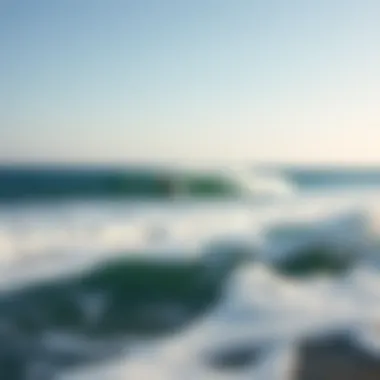
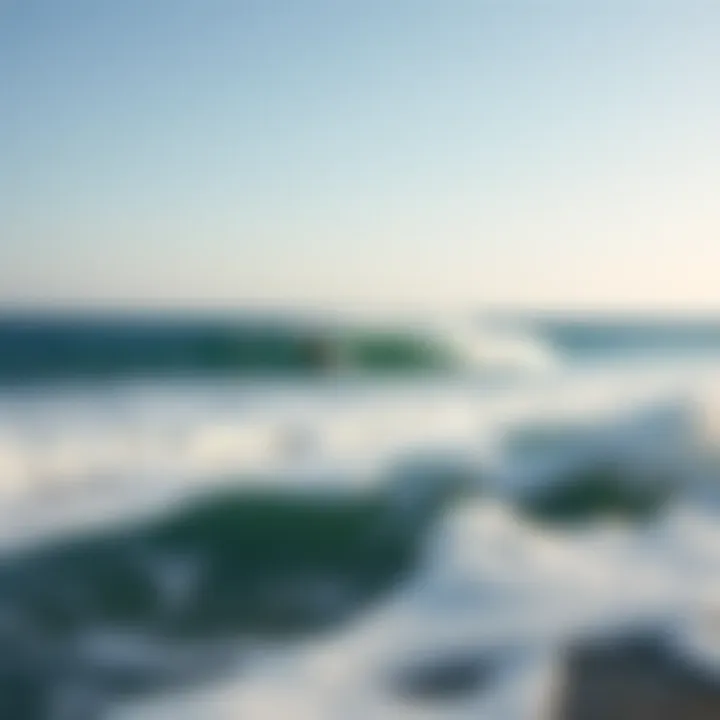
When it comes to kites, understanding the wind conditions is step number one. Kites come in various sizes and designs, each tailored for specific wind conditions.
- Light Wind (Under 12 knots): A larger kite is ideal, as it can catch more air and provide enough lift. A type like the Slingshot Rally is popular because of its good upwind performance in light winds.
- Medium Wind (12-20 knots): A medium-size kite is generally more versatile. Think about trying the Duotone Evo, known for its stability and bounce in this wind range.
- Strong Wind (Above 20 knots): Here, smaller kites must be your go-to. The Ozone Edge can handle high winds exceptionally well without sacrificing control.
Make sure to check the wind forecast before heading out. This will help you decide not only on size but also on the type of kite. The type of riding you prefer, whether it be freestyle, wave riding, or freeriding, will also influence your choice significantly.
Board Selection Criteria
Choosing the right board is just as crucial. The board you select should dovetail with both your skill level and the wind and wave conditions. Keep in mind these considerations:
- Board Size:
- Rockers and Shapes:
- Material and Build:
- Larger Boards: These are more forgiving and provide better floatation which is beneficial in lighter winds.
- Smaller Boards: Useful in strong winds and for aggressive maneuvers.
- Boards with a higher rocker tend to offer a smoother ride over choppy waters. On the flip side, a flatter board will hold speed better on flatter conditions.
- Epoxy boards often provide a balance of flexibility and sturdiness, making them versatile across various conditions.
Understanding the nuances of your gear selection renders your experience not only safer but, most importantly, exhilarating. The right gear coupled with a keen awareness of the conditions can elevate your skills and enjoyment at Tourmaline.
In summary, whether you’re gearing up for a light breeze or the stronger gusts typical of certain seasons, know your board and kite intimately. This will enhance not just performance, but also that essential element of safety. For further insights on gear selections based on conditions, you might find resources like Kiteboarding.com and IKSurf Magazine beneficial.
The Community and Culture of Tourmaline
The essence of the Tourmaline surfing experience goes beyond the waves and currents; it lies deeply anchored in the community and culture that surrounds it. Engaging with local surfers and participating in local events is vital for anyone looking to truly tap into what this spot has to offer. Here, surfers find kinship, mentorship, and a shared love for the ocean that transcends the mere act of riding the waves.
Engaging with Local Surfers
Local surfers are often the lifeblood of Tourmaline Beach. They possess an intricate understanding of the ever-changing surf conditions that might easily elude a novice or a traveler passing through. By interacting with these individuals, one can glean invaluable insights about when to paddle out, the best spots for specific conditions, and perhaps even specific techniques catered to different waves.
When you engage with the locals, you're not just another face in the crowd; instead, you're becoming part of a larger family. Many long-time surfers are more than willing to share their knowledge, making newcomers feel welcomed. Whether it’s chatting about the latest swell during a meal at nearby eateries or sharing tips while waiting for the right wave, these connections can greatly enhance one’s surfing experience.
Additionally, social media platforms, such as Facebook, serve as fertile ground for local surfers to arrange meet-ups or share updates about conditions and community gatherings. Don't hesitate to step into the local surf shops; they are usually brimming with stories and advice about recent conditions or upcoming events. Building a rapport with locals can truly elevate one's experience.
Events and Competitions
The community spirit at Tourmaline is prominently showcased through numerous events and competitions held throughout the year. These gatherings are not just opportunities to compete but serve as platforms for camaraderie, sharing stories, and celebrating the sport itself.
Various competitions cater to a wide range of skill levels, from novice kiteboarders testing their skills for the first time to seasoned veterans showing off their prowess on the water. Events can range from informal local contests to larger-scale competitions that attract attention from across the region. Here are a few notable events:
- Local Surf Competitions: Regularly held, these events usually take place on weekends and include divisions for different skill levels. They often feature prizes sponsored by local shops, encouraging participation while boosting local businesses.
- Beach Clean-Up Days: These gatherings are vital to preserving the beauty of Tourmaline Beach and fostering community spirit. Surfers and beachgoers join forces to pick up litter, making the beach clean and enjoyable for everyone.
- Kiteboarding Festivals: These are grander affairs that may feature live music, food stalls, and demonstrations by professionals. They offer an engaging atmosphere that brings together the local and visiting surf community.
Participating in such events is an opportunity to make memories, meet new friends, and immerse oneself in the culture of Tourmaline. The excitement of competition, the thrill of shared experiences, and the commitment to nature preservation all contribute to the vibrant fabric of the Tourmaline community.
The true heart of surfing at Tourmaline lies not just in the waves but in the people who share them. By embracing the local culture, you enhance your skills and create long-lasting memories.
As your understanding of the community deepens, so too does your connection to the sport, making every ride a rich tableau painted with shared experiences, local lore, and the spirit of adventure.
Ending and Recommendations
In wrapping up our deep-dive into the Tourmaline Surf Report, it’s clear that understanding the intricacies of this surf spot is not just beneficial but vital for anyone hoping to enhance their experience on the waves. The importance of staying informed about local conditions cannot be overstated; they not only dictate your performance but also play a crucial role in ensuring your safety. The confluence of wave patterns, tides, and seasonal shifts offers a unique playground but also presents its challenges.
With the proper information, kiteboarders can optimize their time in the water, tailoring their approach based on current conditions. It's like having a finely tuned compass that guides your adventure – without it, one might find themselves adrift in unfamiliar waves.
Final Thoughts
Reflecting on the valuable insights shared throughout this article, one must appreciate that every session spent at Tourmaline is a unique experience, molded by the interplay of natural elements. The local community, with their wealth of knowledge and shared experiences, is an incredible resource for any surfer keen on mastering these waters.
To illustrate, imagine arriving at Tourmaline on a breezy day, the waves cresting with the perfect rhythm. Engaging with fellow surfers can offer tips on navigating tricky spots or finding the best times to paddle out. This cooperative spirit enhances the joy of the sport and helps build familiarity with Tourmaline's quirks.
Future Perspectives for Tourmaline Surfing
As we look ahead, the trajectory of kiteboarding at Tourmaline promises to be an exciting one. With technological advancements in forecast models and surf gear, which allow for more precise and personalized predictions, surfers will increasingly rely on tools that provide real-time data. By embracing these innovations, kiteboarders can anticipate changes in conditions, thereby maximizing their time on the water.
However, it’s equally important to stay attuned to environmental changes. Climate change, for example, is gradually altering wave patterns and tidal behaviors. Keeping an eye on these shifts will help the surfing community adapt, ensuring that Tourmaline remains a sanctuary for water sports enthusiasts.
Moreover, fostering community events that bring surfers together can cultivate a greater understanding of these conditions. From workshops focused on gear maintenance to contests leveraging the latest surf tech, the possibilities for enhancing the culture surrounding Tourmaline are endless.
In essence, the future of surfing at Tourmaline Beach rests in the hands of its surfers. With a blend of tradition and innovative practices, kiteboarding will flourish, ensuring that this beautiful sport continues to inspire adventurers for generations to come.















